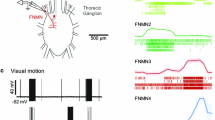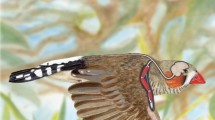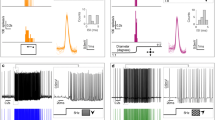Abstract
The study investigates activity changes in neurons of the lateral accessory lobes in the brain of the locust Schistocerca gregaria during wind-elicited tethered flight. Neurons with ascending projections from the ventral nerve cord to the lateral accessory lobes showed flight-associated excitations which were modulated in the flight motor rhythm. Descending neurons with ramifications in the lateral accessory lobes were tonically excited corresponding to flight duration. The onset of wind-elicited responses in the descending neurons preceded the onset of flight motor activity by 22–60 milliseconds. Neurons connecting the lateral accessory lobes with the central body, the anterior optic tubercles, or other brain areas showed a variety of responses including activity changes during flight initiation and flight termination. Activity in many of these neurons was less tightly coupled to the flight situation and often returned to background levels before flight was terminated. Most of the recorded neurons responded, in addition, to stationary visual stimuli. The results suggest that the lateral accessory lobes in the locust brain are integrative links between the central body, visual pathways, and the ventral nerve cord. The possible involvement of these brain areas in flight control is discussed.
Similar content being viewed by others
References
Bausenwein B (1989) Central brain functions in flies can be studied during free behaviour using high resolution 2-deoxyglucose neuronal activity labelling. In: Erber J, Menzel R, Pflüger J, Todt D (eds) Neural mechanisms of behavior. Thieme, Stuttgart New York, p 246a
Boyan G, Williams L, Meier T (1993) Organization of the commissural fibers in the adult brain of the locust. J Comp Neurol 332:358–377
Elson RC (1987) Integration of wing proprioceptive and descending exteroceptive sensory inputs by thoracic interneurones of the locust. J Exp Biol 128:193–218
Hanesch U, Fischbach KF, Heisenberg M (1989) Neuronal architecture of the central complex in Drosophila melanogaster. Cell Tissue Res 257:343–366
Hensler K (1988) The pars intercerebralis neurone PI(2)5 of locusts: convergent processing of inputs reporting head movements and deviations from straight flight. J Exp Biol 140:511–533
Hensler K (1989) Corrective flight steering in locusts: convergence of extero- and proprioceptive inputs in descending deviation detectors. In: Singh RN, Strausfeld NJ (eds) Neurobiology of sensory systems. Plenum Press, New York, pp 531–554
Hensler K (1992) Neuronal co-processing of course deviation and head movement in locusts. I. Descending deviation detectors. J Comp Physiol A 171:257–271
Hensler K, Robert D (1990) Compensatory head rolling during corrective flight steering in locusts. J Comp Physiol A 166:685–693
Homberg U (1985) Interneurons of the central complex in the bee brain. J Insect Physiol 31:251–264
Homberg U (1987) Structure and functions of the central complex in insects. In: Gupta AP (ed) Arthropod brain: its evolution, development, structure, and functions. Wiley, New York, pp 347–367
Homberg U (1991) Neuroarchitecture of the central complex in the brain of the locust Schistocerca gregaria and S. americana as revealed by serotonin-immunocytochemistry. J Comp Neurol 303:245–254
Homberg U (1993) Sensory-motor integration in the lateral accessory lobes of the locust brain. In: Elsner N, Heisenberg M (eds) Gene — brain — behaviour. Thieme, Stuttgart New York, p 161
Homberg U, Hildebrand JG (1989) Serotonin-immunoreactive neurons in the median protocerebrum and suboesophageal ganglion of the sphinx moth Manduca sexta. Cell Tissue Res 258:1–24
Homberg U, Hildebrand JG (1991) Histamine-immunoreactive neurons in the midbrain and suboesophageal ganglion of the sphinx moth Manduca sexta. J Comp Neurol 307:647–657
Homberg U, Kingan TG, Hildebrand JG (1987) Immunocytochemistry of GABA in the brain and suboesophageal ganglion of Manduca sexta. Cell Tissue Res 248:1–24
Homberg U, Kingan TG, Hildebrand JG (1990) Distribution of FMRFamide-like immunoreactivity in the brain and suboesophageal ganglion of the sphinx moth Manduca sexta and colocalization with SCPB-, BPP-, and GABA-like immunoreactivity. Cell Tissue Res 259:401–419
Huber F (1960a) Experimentelle Untersuchungen zur nervösen Atmungsregulation der Orthopteren (Saltatoria, Gryllidae). Z Vergl Physiol 43:359–391
Huber F (1960b) Untersuchungen über die Funktion des Zentral-nervensystems und insbesondere des Gehirns bei der Fortbewegung und Lauterzeugung der Grillen. Z Vergl Physiol 44:60–132
Huber F (1967) Central control of movements and behavior in invertebrates. In: Wiersma CAG (ed) Invertebrate nervous system. Univ of Chicago Press, Chicago, pp 333–351
Kanzaki R, Shibuya T (1986) Descending protocerebral neurons related to the mating dance of the male silkworm moth. Brain Res 377:378–382
Kanzaki R, Arbas EA, Hildebrand JG (1991) Physiology and morphology of descending neurons in pheromone-processing olfactory pathways in the male moth Manduca sexta. J Comp Physiol A 169:1–14
Müller M, Homberg U (1994) Influence of visual stimuli on the activity of neurons in the central complex of the locust Schistocerca gregaria. In: Elsner N, Breer H (eds) Göttingen neurobiology report 1994. Thieme, Stuttgart New York, p 462
Müller NR, Buchner E, Heisenberg M (1992) 3H-deoxyglucose activity labeling in the central brain of Drosophila melanogaster monitors different behavioral situations. In: Eisner N, Richter DW (eds) Rhythmogenesis in neurons and networks. Thieme, Stuttgart New York, p 171
Müller NR, Buchner E, Heisenberg M (1993) 3H-deoxyglucose activity labelling in the central complex of Drosophila melanogaster monitors different behavioral situations and different visual stimuli. In: Elsner N, Heisenberg M (eds) Gene — brain — behaviour. Thieme, Stuttgart New York, p 205
Osorio D (1992) Retinotopic vision in insects. In: Pinter RB, Nabet B (eds) Nonlinear vision: determination of neural receptive fields, function, and networks. CRC Press, Boca Raton, pp 377–390
Otto D (1971) Untersuchungen zur zentralnervösen Kontrolle der Lauterzeugung von Grillen. Z Vergl Physiol 74:227–271
Pflüger HJ, Bräunig P, Hustert R (1981) Distribution and specific central projections of mechanoreceptors in the thorax and proximal leg joints of locusts. II. The external mechanoreceptors: hair plates and tactile hairs. Cell Tissue Res 216:79–96
Reichert H (1993) Sensory inputs and flight orientation in locusts. Comp Biochem Physiol 104A:647–657
Robert D, Rowell CHF (1992) Locust flight steering. I. Head movements and the organization of correctional manoeuvers. J Comp Physiol A 171:41–51
Robertson RM, Pearson KG (1985) Neural networks controlling locomotion in locusts. In: Selverston AI (ed) Model neural networks and behavior. Plenum, New York London, pp 21–35
Ronacher B, Wolf H, Reichert H (1988) Locust flight behavior after hemisection of individual thoracic ganglia: Evidence for hemiganglionic premotor centers. J Comp Physiol A 163:749–759
Rowell CHF (1988) Mechanisms of flight steering in locusts. Experientia 44:389–395
Rowell CHF (1989) Descending interneurones of the locust reporting deviation from flight course: What is their role in steering? J Exp Biol 146:177–194
Rowell CHF (1993) Intersegmental coordination of flight steering in locusts. Sem Neurosci 5:59–66
Schäfer S, Bicker G (1986) Distribution of GABA-like immunoreactivity in the brain of the honeybee. J Comp Neurol 246:287–300
Scharstein H (1989) A universal projector for optomotor stimulation. In: Elsner N, Singer W (eds) Dynamics and plasticity in neuronal systems. Thieme, Stuttgart New York, p 116
Snodgrass RE (1929) The thoracic mechanism of a grasshopper and its antecedents. Smithson Misc Collect 82:1–111
Sternberger LA (1986) Immunocytochemistry. Wiley, New York
Stevenson PA, Kutsch W (1987) A reconsideration of the central pattern generator concept for locust flight. J Comp Physiol A 161:115–129
Strausfeld NJ (1976) Atlas of an insect brain. Springer, Berlin Heidelberg New York
Strauß R, Hanesch U, Kinkelin M, Wolf R, Heisenberg M (1992) no bridge of Dmsophila melanogaster — portrait of a structural mutant of the central complex. J Neurogenet 8:125–155
Strauss R, Heisenberg M (1993) A higher control center of locomotor behavior in the Dmsophila brain. J Neurosci 13:1852–1861
Wegerhoff R, Breidbach O (1992) Structure and development of the larval central complex in a holometabolous insect, the beetle Tenebrio molitor. Cell Tissue Res 268:341–358
Wendt B, Homberg U (1992) Immunocytochemistry of dopamine in the brain of the locust Schistocerca gregaria. J Comp Neurol 321:387–403
Williams JLD (1972) Some observations on the neuronal organisation of the supra-oesophageal ganglion in Schistocerca gregaria Forskål with particular reference to the central complex. PhD Thesis, University of Wales
Williams JLD (1975) Anatomical studies of the insect central nervous system: A ground-plan of the midbrain and an introduction to the central complex in the locust, Schistocerca gregaria (Orthoptera). J Zool (Lond) 76:67–86
Wolf H (1991) Sensory feedback in locust flight patterning. In: Armstrong DM, Bush BMH (eds) Locomotor neural mechanisms in arthropods and vertebrates. Manchester Univ Press, Manchester, pp 134–148
Wolf H, Pearson KG (1987) Flight motor patterns recorded in surgically isolated sections of the ventral nerve cord of Locusta inigratoria. J Comp Physiol A 161:103–114
Wolf H, Ronacher B, Reichert H (1988) Patterned synaptic drive to locust flight motoneurons after hemisection of thoracic ganglia. J Comp Physiol A 163:761–769
Author information
Authors and Affiliations
Rights and permissions
About this article
Cite this article
Homberg, U. Flight-correlated activity changes in neurons of the lateral accessory lobes in the brain of the locust Schistocerca gregaria . J Comp Physiol A 175, 597–610 (1994). https://doi.org/10.1007/BF00199481
Accepted:
Issue Date:
DOI: https://doi.org/10.1007/BF00199481




